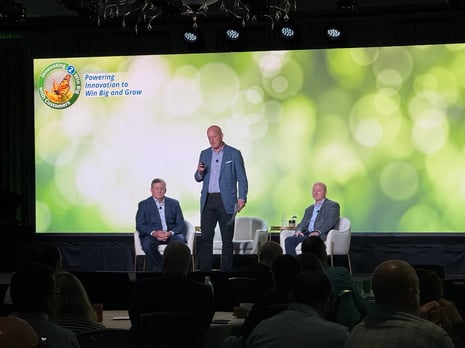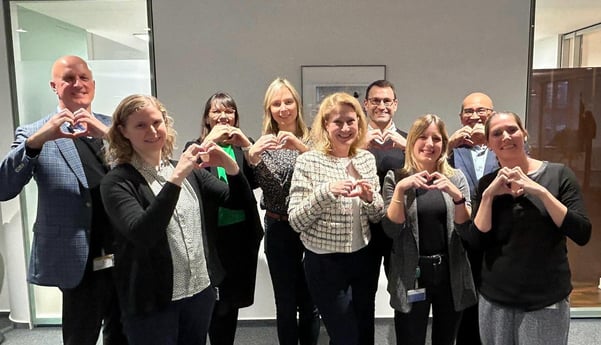What does it take to build a food manufacturing supply chain that’s fast, safe, and resilient in today’s ever-changing market?
We’re excited to shine a spotlight on Eric Seip, SVP of Global Operations and Chief Supply Chain Officer at Ingredion, who will be joining us at the American Food Manufacturing Summit. With a wealth of experience leading large-scale operations and supply chain transformations, Eric brings a unique perspective on driving efficiency, safety, and operational excellence across complex global networks.
In his session, “Transforming Supply Chains: Scaling Excellence, Safety, and Efficiency,” Eric will explore actionable strategies for modernizing supply chains in today’s fast-paced food manufacturing environment. Prior to him taking the stage at the American Food Manufacturing Summit, get a sneak preview below!

Can you introduce yourself, and share more about your career journey leading up to your current role as the SVP, Global Operations, Chief Supply Chain Officer at Ingredion?
I spent the first 20 years of my career in discrete manufacturing, with the last 10 years leading global operations - similar to what I have today with Ingredion. I then spent a dozen years in the specialty chemicals industry, leading Global Supply Chain (synonymous with Operations).
Most of the time there, I was focused on serving the oil and gas industry. Therefore, I touched a lot of geographies in the world that many industries don't touch. After we IPO'd the energy business out of Ecolab, I came to Ingredion, where I've been nearly five years. My focus is on moving from a decentralized operating model, to a global operating model, and shifting the trajectory of operations performance to enhance company results.
As your session will explore redefining global operations, what were the critical factors that guided the transition to a unified supply chain model, and how did you ensure alignment across regions?
It starts with understanding the basic business, and understanding what the Board of Directors aspirations are. Where I really dug in was trying to get the right team put together. This goes for talent internally, as well as supplementing with some external hires. This helped to build out the capabilities of what the future state would look like—because you need people to build out the processes. We spent a lot of time, in the first year, doing a lot of external benchmarking as we built a three-year road map. We wanted to get that as right as we could, in an order that made sense and was executable—while we were juggling the COVID crisis.
When you started this effort, not everyone shared the vision. What did you see from your leadership team and from others in the company that told you they’d finally bought in?
I'd say early on there wasn't broad buy-in to it—it was a major shift in the more than 115-year history of the company. We were in a global crisis with COVID, and it wasn't the best time to look at changing the execution model. With that said, it was what it was.
We needed to be different, we needed to be better.
Trying to get the business buy-in was hard and it was hard for valid reasons. Our service was not good. Our process safety record at that time was not good, and we didn't have visibility needed to improve. It was tough. So, we focused on two things: improving our safety and improving our service.
We finally started to make progress, and when results start to come, people start to buy in.

What are the key digital tools you’ve implemented to increase transparency within your supply chain, and how have they impacted operational efficiency?
We use the X-Matrix. It existed prior to me being at Ingredion, but it was not fully deployed. As a global Operations team, we built our first X-matrix at the end of 2021 going into 2022, and we set six breakthrough measures. We looked out, ‘22, ‘23, ’24, asking ourselves, “Where do we want to drive those six breakthrough areas by 2024?”.
There was a lot of, “We can't have just six metrics,” and “This isn't going to work.”
There was a lot of disbelief, even by the Operations team, but they gave me trust and we forged ahead. It took time to help colleagues understand that the use of the X-Matrix doesn’t mean you only have six metrics—but it means, in the hierarchy of things, there are six things that matter more than everything else. When we do the look back, we had five of the six metrics green by the end of year two of our three-year journey.
Then, we worked like you do in a Hoshin planning model. We cascaded those throughout the organization—across regions, businesses, plants, and functions. While that's not a perfect science, by and large, we're aligned correctly on the things that we're working on. We did that all very manually. Now, the data is being automated through our Global Operations Analytics Team, which we call the GOAT. We talk about right data, to the right people at the right time. So that's one area where we're using a digital tool, and it starts with our basic metrics.
Two key ways we have advanced our use of digital tools are through improvements in demand forecasting and the strategic deployment of online sensors. Our work on demand forecasting is an area where I think we're moving into the leading quadrant now in terms of what we're doing, and we’re getting much better.
The other exciting area is our reliability team’s strategic deployment of online sensors, particularly on pieces of equipment that are single point failure mechanisms for a given plant. These sensors allow us to see the potential for failure earlier in our processes, versus waiting for our scheduled preventative maintenance. It also avoids the issue of not knowing we have a problem until equipment fails.
If we can see a change in vibration, a change in frequency—any change that suggests an anomaly or a point of weakness—we can address the problem before the process changes. This is helping our OEE improve.
What are some of the biggest challenges in aligning strategic sourcing to achieve cost optimization, and how have you overcome them?
I think we have two hurdles, which are not necessarily unique to Ingredion. One would be that people not in procurement want to own the relationship and the negotiation with their supplier(s), so there’s resistance to shift to a central procurement mode. The second would be that procurement had been viewed as very transactional, and not strategic. Yet anyone who’s worked in an organization with an excellent procurement process knows that it isn't just about getting the right price. That's certainly important because, as a company, we must remain cost competitive.
However, there's so much more that comes with procurement, and that team should be part of setting your strategy and helping facilitate your strategy. We did a significant amount of work on business continuity and ensuring we have multiple supply channels (even if from the same supplier) in the event of unforeseen circumstances. We are now partnering with more and more suppliers on innovation, and we very much believe in a Total Cost of Ownership mindset in this space.
What role does leadership play in embedding safety standards at Ingredion, and how do you ensure that safety is prioritized at all levels of the organization?

Leadership sets your standards, and what matters to leadership is going to matter to the company. We talk about care, customer capacity and cost. We prioritize them in that order.
That's a repeated message, in every one of our global operations town halls. It's also how I try to run meetings. It's how when I visit a plant, I don't want to talk about their cost per ton. I want to talk about their safety performance. I want to talk about environmental excursions, greenhouse gas emissions, and other things that are related to how we’re doing work. It’s about reminding everyone that safety is the ultimate demonstration of our company’s Care First value.
I think one of the things that we re-learned this year on our safety observations, is that leadership wasn't quite as active on observations and gemba walks as we needed leadership to be.
We reinvigorated that and put some tight expectations and metrics around it along with some reporting and accountability. Not only have we seen those numbers snap back to where they should be, but we've also seen our lagging indicator of Total Recordable Injury Rate (TRIR) come back down to a level that we expect it to be. It's about the power of reinforcement: when leadership walks the talk, the results come. But if we only talk the talk, it’s quickly seen through—the organization follows and the results lag.
What are some of the key considerations when integrating new supply chain technologies or processes to support Ingredion’s specialized product expansion?
I like the 70/20/10 approach where the majority of what we do should be standardized around the world, while respecting that at times there are legitimate reasons to do some things differently. We should take a similar approach when it comes to digital technologies, but with even greater standardization.
For this, it needs to be more like 95/5/0 because we need a consistent application that's going to drive results. That’s the only way you'll leverage scale at the end of the day. You can have different process inputs to get to the standardized digital platform, but I think you have to run a standardized global digital platform.
Our planning system is a perfect example. When we got everybody onto the same planning system globally, we generated really good results that you can't get if half the company chooses to use a different digital tool. We’re embarking on a new five-year road map that's going to have a lot more steps to take, due to many things that are still decentralized around the world. The team and I are working on this, asking:
“What does that road map look like by function? What comes first, second, and third over the next five years? What are all the interdependencies that are sometimes harder to see?”
The goal is to land on a rollout plan that allows us to get more right than wrong, all while driving our performance for our people and customers to even higher levels.

If we can help our customers to improve their processes to help us get the product out the door on time to them, we all win, right? But if we don't, if we don't even have the data to look at, nobody's paying attention to it, and we're not making things better for our customers or for our own company.

We’re excited to have Eric share his expertise with us and look forward to his session, where he’ll dive deeper into the innovations that are shaping the future of food manufacturing. Don’t miss the opportunity to hear from Eric and other thought leaders at this year’s American Food Manufacturing Summit, taking place November 4-5 in Chicago.
For more information and registration details, visit foodmansummit.com
%20(1).png?width=773&height=112&name=Generis%20Logo%20full%20Colour%20(Large)%20(1).png)

-Nov-13-2025-01-18-02-9699-PM.png)
-2.png)
.png)